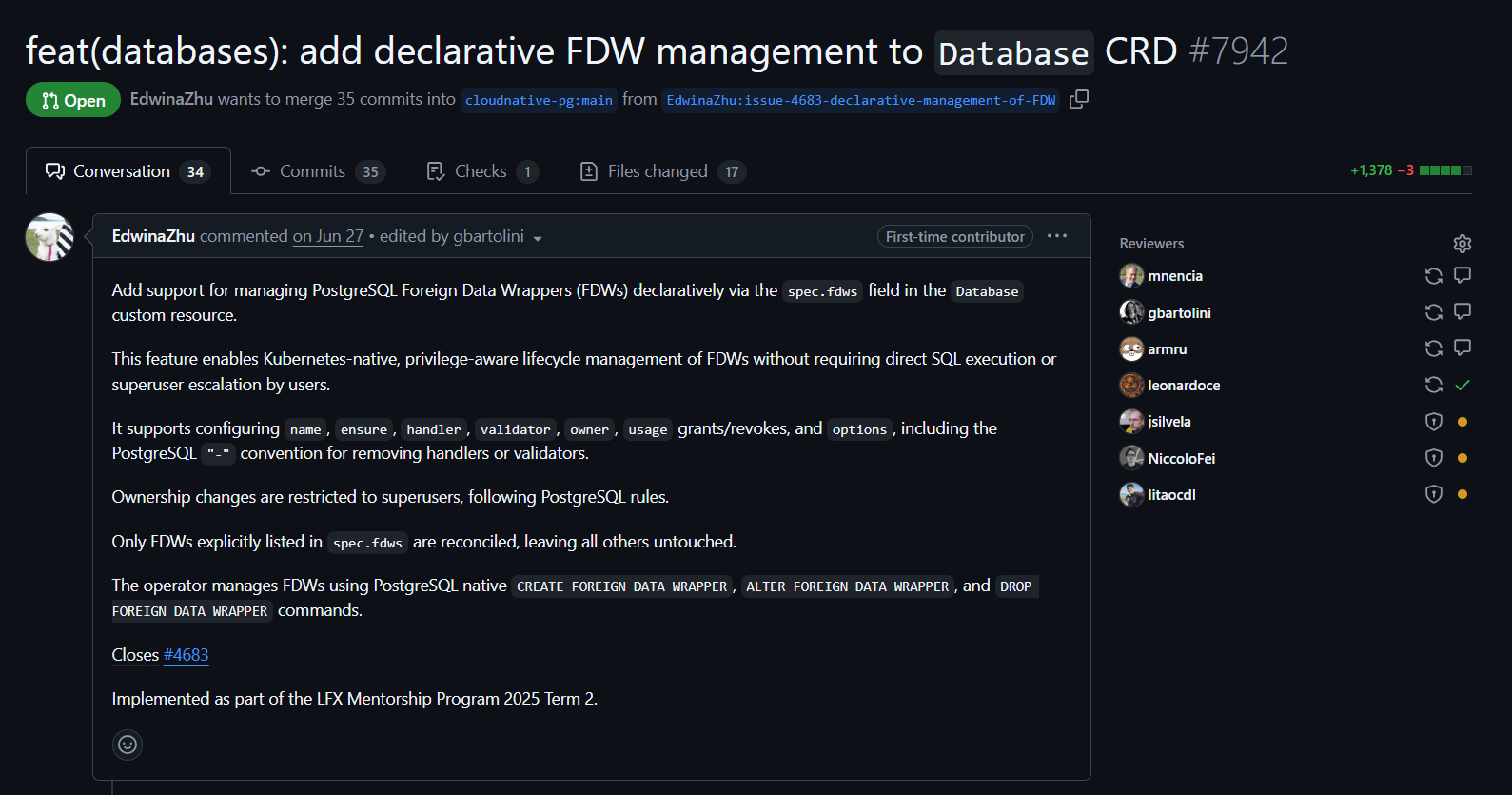Migrations With Atlas and CloudNativePG
May 14, 2025 • 5 minutes

One of the most important practices when developing code that relies on databases is to use database migration tools for change management. It’s something you will learn, even if it has to be the hard way. (Another thing I see too many newcomers learning the hard way is to take backups often, and to test those backups regularly.)
In the post Developing webapps with CloudNativePG, we mentioned Liquibase, which is one of the most popular database migration tools.
Traditional database migration tools assume a connection is available to the target database. In the context of Kubernetes, and of Postgresql clusters built using CloudNativePG, to use such a tool we would need to expose the database service outside the Kubernetes cluster, for example via port forwarding, an ingress, or similar solutions.
The Atlas database migration tool includes a Kubernetes operator that lets us manage database migrations within Kubernetes. Let’s see an example of how to do that:
Step 0: install CloudNativePG and create a Postgres cluster
First of all, you should have CloudNativePG running on your kubernetes cluster, and a Postgres cluster created with CloudNativePG. If you don’t yet have this, you can follow the CloudNativePG quickstart.
Whether you follow the quickstart or you already had a CloudNativePG/Postgres
cluster up and running, we’ll assume for the rest of this post that your
CloudNativePG cluster is called cluster-example.
Step 1: install the Atlas operator
To install the Atlas operator, you can use Helm:
helm install atlas-operator oci://ghcr.io/ariga/charts/atlas-operator
Note that you may need an access token to retrieve the image from the GHCR registry (please see the GHCR documentation for details).
After Atlas is installed, you will notice new CRDs in your Kubernetes installation:
> kubectl get crd | grep atlas
atlasmigrations.db.atlasgo.io <timestamp>
atlasschemas.db.atlasgo.io <timestamp>
Step 2: make changes to the database using Atlas
We will use the Atlas Schema CRD to manage migrations. You may want to open the Atlas operator quickstart for reference, though we’re not going to follow it exactly.
To apply a migration, we need credentials to access our target database.
The Atlas operator quickstart uses the urlFrom
stanza, but with CloudNativePG there is a more convenient way.
From Step 0, we have assumed we have a CloudNativePG cluster called
cluster-example.
CloudNativePG, by default, creates a database called app on clusters, and
a user app whose credentials are held in a Secret called
cluster-example-app:
> kubectl get secrets | grep app
cluster-example-app kubernetes.io/basic-auth 9 18h
You can inspect the contents of the secret running
kubectl get secrets cluster-example-app -o yaml,
and you will find that it contains a key called password, holding of course
the password for the app user (base64 encoded).
In addition to the cluster-example-app Secret, the CloudNativePG operator
creates Services for Postgres. In particular, we will want to use the ReadWrite
service, called cluster-example-rw, for the migrations.
We’re going to use the credentials object
from the AtlasSchema CRD to reference
the password and the service. Following along the Atlas Operator Quickstart, we
create a migration defining a table called t1. Save the following to a file
named atlas-schema.yaml.
Notice how CloudNativePG automatically produced the values we need to put
in the passwordFrom and host fields:
apiVersion: db.atlasgo.io/v1alpha1
kind: AtlasSchema
metadata:
name: atlasschema-pg
spec:
credentials:
scheme: postgres
host: cluster-example-rw.default
user: app
passwordFrom:
secretKeyRef:
key: password
name: cluster-example-app
database: app
port: 5432
parameters:
sslmode: disable
schema:
sql: |
create table t1 (
id int
);
Then apply it: kubectl apply -f atlas-schema.yaml.
In a few seconds, you should be able to see the Schema has been reconciled:
> kubectl get atlasschemas.db.atlasgo.io
NAME READY REASON
atlasschema-pg True Applied
To verify the effects on the database, let’s get a psql session open on one
of our instances:
> kubectl exec -ti cluster-example-1 -- psql app
Defaulted container "postgres" out of: postgres, bootstrap-controller (init)
psql (17.4 (Debian 17.4-1.pgdg110+2))
Type "help" for help.
app=# \dt
List of relations
Schema | Name | Type | Owner
--------+------+-------+-------
public | t1 | table | app
(1 row)
app=# \d t1
Table "public.t1"
Column | Type | Collation | Nullable | Default
--------+---------+-----------+----------+---------
id | integer | | |
As suggested in the Atlas Quickstart, we can modify the schema in the
atlas-schema.yaml file, and then re-apply with
kubectl apply -f atlas-schema.yaml, and the Atlas operator will again
reconcile the database to the desired state.
What’s the point? DevOps
Let’s say you have an application that uses a database. In production, the database may hold your customers’s data, purchase history, financial transactions, perhaps maps using PostGIS, etc.
Application developers will regularly need to add functionality, and often
that will involve creating new tables, schemas, procedures, indexes, perhaps
doing some INSERT statements to populate static data, etc.
The developers will be using a development database, probably hosted in their
dev machines.
There might be another database for the purpose of automated testing, and
of course there’s the production database, where the changes will need to be
applied in the end. These different databases will have different data in them,
and different loads.
Add time and other developers, and you have a big chance for snafus of the type
“but it worked on my machine!”
Database migration tools help manage this, bringing DevOps to this area of
databases. Atlas, by working as a Kubernetes operator, makes the dev/prod
transition even smoother.
But it’s not enough to use good tools. Remember the Agile manifesto:
“individuals and interactions over processes and tools”.
You can find an overview of the challenges posed by database change management
at DORA.
Using CloudNativePG, with its services and credentials secrets created out of the box, together with Atlas, will enable the developers to create migrations in their development Kubernetes installations, update the YAML files for Atlas in version control to share with the other devs, and eventually apply to the production database smoothly.
This intro was just to whet your appetite. There is plenty more to learn with Atlas.
Categories in this blog post
All categories
- Alerts
- Applications
- Bake
- Benchmarks
- Blog
- Chaos-Engineering
- Ciclops
- Cloudnativepg
- Cncf
- Cnpg
- Community
- Containers
- Continuous-Delivery
- Continuous-Integration
- Dashboards
- Dba
- Debian
- Devops
- Docker
- Extensions
- Failover
- FailoverQuorum
- FDW
- ForeignData
- Github
- Grafana
- Graphql
- Hasura
- Helm
- Hetzner
- Imagecatalog
- Images
- ImageVolume
- Information
- K8s
- Kubectl
- Kubernetes
- Lfx
- Linux
- Maintenance
- Mentorship
- Migrations
- Minecraft
- Modernize
- Open-Source
- Operator
- Pdb
- Performance
- Pg16beta1
- Pgbouncer
- PgTAP
- PGXN
- Pooler
- Postgres
- Postgresql
- Preview
- Programming
- Prometheus
- Rails
- React
- Release
- Ruby
- Service-Mesh
- Spotlight
- Sqitch
- Tablespaces
- Testing
- Tutorial
- UX
- Volumesnapshots








